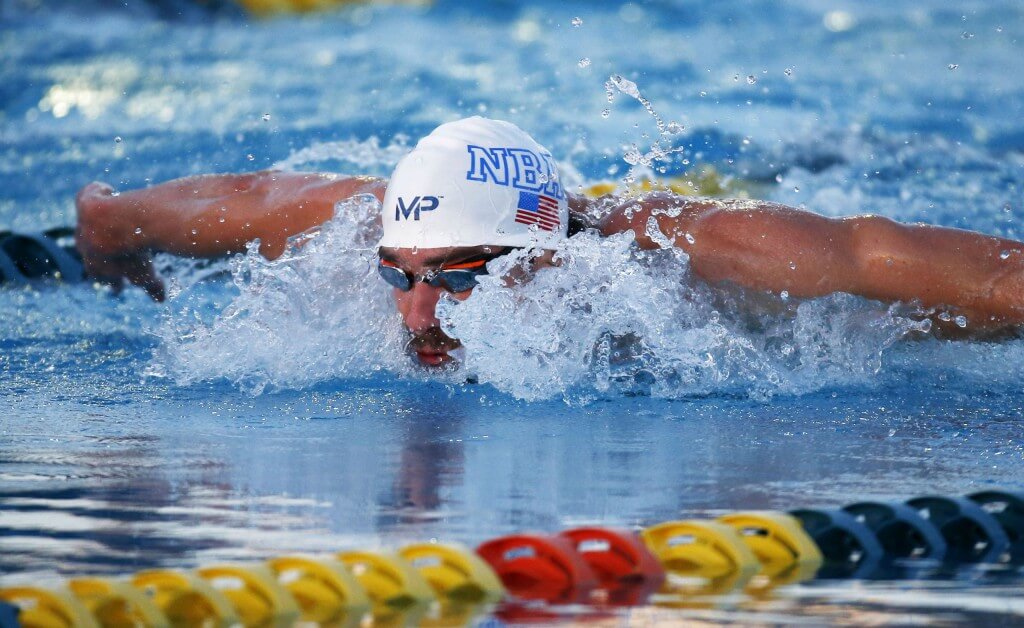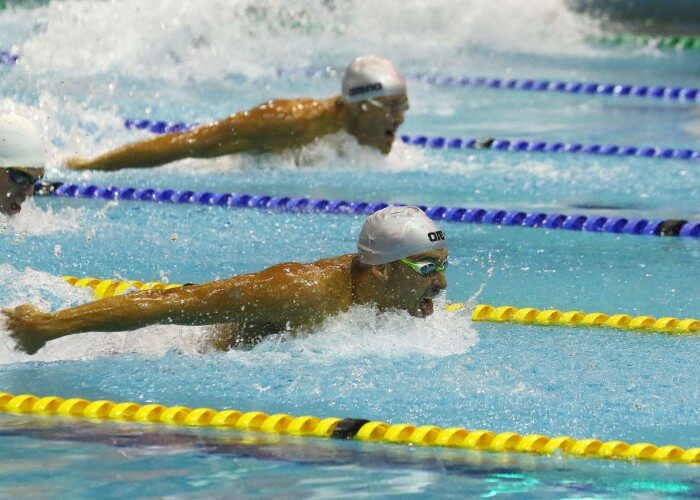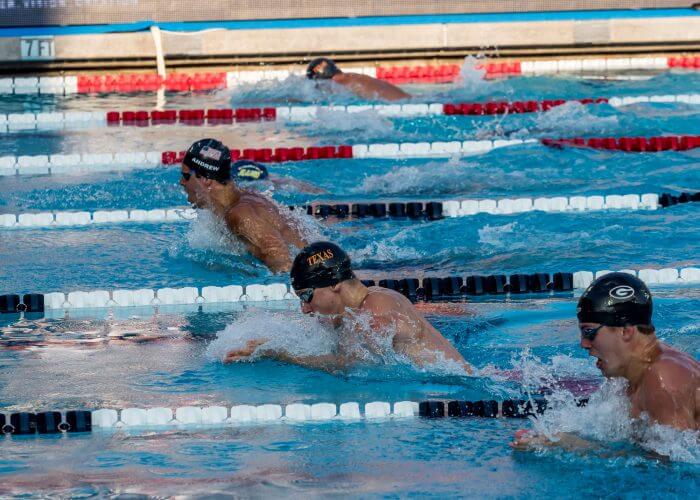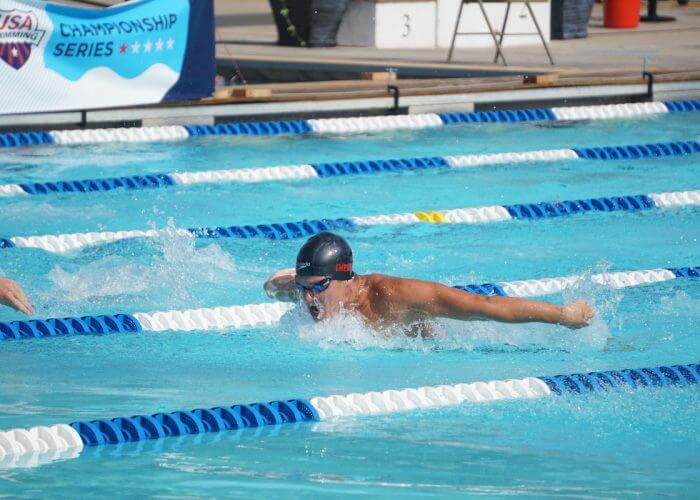The History of Butterfly: Then and Now

By Proteeti Sinha, Swimming World College Intern.
Some swimmers say that if the worst pain you’ve ever experienced is a broken heart, then you haven’t swum a 200 fly.
The butterfly is typically considered to be the most challenging of all four strokes – it demands endurance, skill and synchronicity. Contrary to popular belief, the peak speed reached in butterfly is actually faster than freestyle. The double arm pulling action has great propulsive potential, and when combined with the downbeat of the kick, is faster than the single-arm pull in freestyle.
Spanning over two decades, the story of how butterfly came to be involves three things that at first glance do not appear to be related: a fish, the Manhattan Project and arthritis.
In the Beginning

Photo Courtesy: Anesh Debiky/Swimming South Africa
Butterfly evolved from an effort to swim faster breaststroke. No single person is credited with the formation of the stroke. Rather, it is attributed to multiple people, all of whom tried to use above-the-water recovery while swimming breaststroke. Officially, the International Swimming Hall of Fame recognizes Sydney Cavill of Australia as the original creator of the stroke.
Butterfly Then

Photo Courtesy: Peter H. Bick
In late 1933, Henry Myers swam a version of the breaststroke-butterfly at the Brooklyn Central YMCA. David Armbruster, who was the swimming coach at the University of Iowa, formulated a method to bring the arms forward out of the water while swimming breaststroke in 1934. In 1935, a swimmer from the University of Iowa (a student of Armbruster), Jack Sieg, developed a kicking technique that is an earlier version of today’s dolphin kick. Together, Armbruster and Sieg discovered that the combination of the kick and arm stroke, you have a faster and more streamlined stroke.
By another account, physicist Volney C. Wilson is credited with an early form of the butterfly kick. In Richard Rhodes’ book The Making of the Atom Bomb, Wilson – who was a part of the Manhattan Project – is described as closely examining how fish swam. Mimicking this undulating motion, he used this new kick along with the breaststroke pull at the 1938 Olympic Trials. However, he was disqualified, as this particular mixture of breaststroke and butterfly was not legal per FINA regulations.
In 1952, FINA decided to split the breaststroke and butterfly into autonomous strokes. The formal butterfly events were first contested at the 1956 Olympic Games in Melbourne.
Modern Butterfly

Photo Courtesy: Aidan Cho
While he was not the first to use the mixed butterfly-breaststroke, Jiro Nagasawa of Japan is credited with the modern butterfly stroke. Nagasawa’s story is unique. At the 1952 Helsinki Olympics, he finished sixth in the 200 breast due to arthritis in both his knees. Because of this struggle with arthritis, he changed his breaststroke kick to the dolphin kick, which was far more powerful. By 1956, Nagasawa had set five world records in the 200m and 220y butterfly. He is also credited with introducing this stroke to Japan and Asia.
The IMplications
Before butterfly became a FINA-ratified stroke, IM races had just three strokes and were only three or six pool lengths. At the time, the race was known as “three-stroke medley”. In the 1950s, the butterfly leg was added to the IM, thus changing the events to the modern 200 and 400 IM races.
When FINA first included the stroke, the men swam the 200 butterfly while the women swam the 100 butterfly. Today, both men and women swim the 50, 100 and 200 butterfly at meets across the world.
Did you learn something new? Tag a butterflyer in the comments!
-All commentaries are the opinion of the author and do not necessarily reflect the views of Swimming World Magazine nor its staff.




My dad Burwell Jones still holds the World Record in the 150 IM ( before butterfly)
Eney Jones, I love that!
Eney I wish they swim had that event ?
Scott Vank do it now!
Personally, I’d like to leave out breaststroke
Eney 150 w/ no freestyle ?????
Interesting! Learnt quite a lot and so well written as always!
This is wonderful!
Wonderfully expressed your thoughts…so well written….Go ahead with your lovely ideas..
Wonderfully expressed your thoughts…so well written….Go ahead with your lovely ideas..
That is so cool!
Very interesting information!!! Nice job Proteeti!!
How about John Higgins? He was 4th in the 200 breaststroke at the 36 Olympics using butterfly arms. He also set the world 100 meter breaststroke record using the same stroke. He told me once that he could keep the stroke going for about 175 meters before having to return to normal breaststroke. A legend!!
Stu Marvin and Herb Kane (hope I got his last name correct).
Very cool!
Tallulah Chesworth
Wow interesting read
?Brett Lullo?
Seems like Dr Bill Yorzyk and Coach Jack Nelson warrant mention for their butterfly in the 1956 Melbourne Olympics for Team USA.
Seems like coach Charles Silvia Ana Bill Yorzyk have been left out.
Yara E Freytes. Luis Rosario
Fly used to hurt so good ?
One of the swim dad’s I knew as a swimmer swam the fly with the breaststroke kick as it was the way in his younger years! We all tried it, not an easy feat!
Meredith Berglund
Toot Wardlaw
Informative article. In India, we swam Butterfly with fly arms and breaststroke kick(which was called orthodox kick butterfly) till 1968
100% worth a read
Excellent
Interesting information, great article!
Intriguing read…keep them coming Proteeti !!
Intriguing read…keep them coming Proteeti !!
Wonderful Quote to start this very informative and we’ll researched article on the evolution of the Butterfly Stroke. Keep them coming dear Proteeti. You have a flair for writing and swimming is a sport you excelled. A combination of the two is what makes your articles so riveting. Cheers! Way to Go!
Well written and informative
Keep it up
For a person who can swim neither breaststroke nor butterfly, it was a very interesting article! Keep it going!!
Informative. Keep up your good work.
Nice article and very informative also.
Amazing article…Keep updating us on such trivia
– Samrat
Wow! This was an interesting read!
Keep it up Pro
Learnt so much about the evolution of butterfly! Keep up the good work Proteeti
Very well written Pro…. though I have been swimming for the last 40 years, I’ve never attempted butterfly
So much to learn from your thoroughly researched and practised article…great job Proteeti
Don’t know anything about swimming. But how nicely you have explained everything. Good work. Keep it up!
My daughter tells me Butterfly is way more difficult than any other stroke. Being a virtually non swimmer I have never really appreciated her words ( or feelings !). Thanks for opening my eyes.
Tailor Shop Tailor Shop
Carrie Erzen Stolar
Very informative and interesting read.
Jose Luis Davila Gustavo Davila
I love to fly! My favorite!!
1938 or did you mean 1948 Olympic Trials?
Wonderful exposition of a subject even swimmers didn’t know much about .
I am much wiser now .